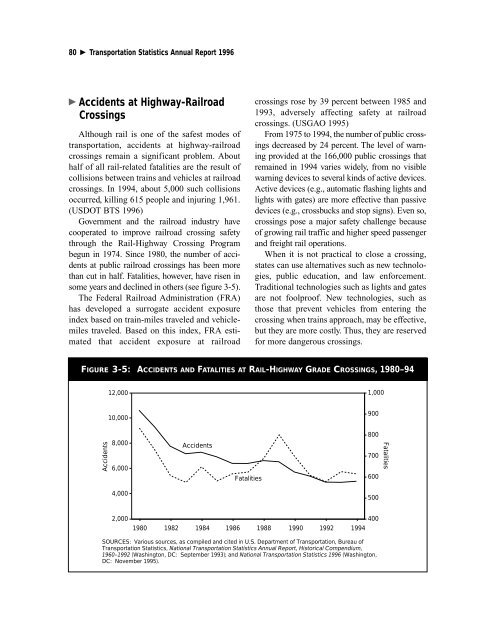table of contents - Research and Innovative Technology ...
table of contents - Research and Innovative Technology ...
table of contents - Research and Innovative Technology ...
You also want an ePaper? Increase the reach of your titles
YUMPU automatically turns print PDFs into web optimized ePapers that Google loves.
80 � Transportation Statistics Annual Report 1996<br />
� Accidents at Highway-Railroad<br />
Crossings<br />
Although rail is one <strong>of</strong> the safest modes <strong>of</strong><br />
transportation, accidents at highway-railroad<br />
crossings remain a significant problem. About<br />
half <strong>of</strong> all rail-related fatalities are the result <strong>of</strong><br />
collisions between trains <strong>and</strong> vehicles at railroad<br />
crossings. In 1994, about 5,000 such collisions<br />
occurred, killing 615 people <strong>and</strong> injuring 1,961.<br />
(USDOT BTS 1996)<br />
Government <strong>and</strong> the railroad industry have<br />
cooperated to improve railroad crossing safety<br />
through the Rail-Highway Crossing Program<br />
begun in 1974. Since 1980, the number <strong>of</strong> accidents<br />
at public railroad crossings has been more<br />
than cut in half. Fatalities, however, have risen in<br />
some years <strong>and</strong> declined in others (see figure 3-5).<br />
The Federal Railroad Administration (FRA)<br />
has developed a surrogate accident exposure<br />
index based on train-miles traveled <strong>and</strong> vehiclemiles<br />
traveled. Based on this index, FRA estimated<br />
that accident exposure at railroad<br />
crossings rose by 39 percent between 1985 <strong>and</strong><br />
1993, adversely affecting safety at railroad<br />
crossings. (USGAO 1995)<br />
From 1975 to 1994, the number <strong>of</strong> public crossings<br />
decreased by 24 percent. The level <strong>of</strong> warning<br />
provided at the 166,000 public crossings that<br />
remained in 1994 varies widely, from no visible<br />
warning devices to several kinds <strong>of</strong> active devices.<br />
Active devices (e.g., automatic flashing lights <strong>and</strong><br />
lights with gates) are more effective than passive<br />
devices (e.g., crossbucks <strong>and</strong> stop signs). Even so,<br />
crossings pose a major safety challenge because<br />
<strong>of</strong> growing rail traffic <strong>and</strong> higher speed passenger<br />
<strong>and</strong> freight rail operations.<br />
When it is not practical to close a crossing,<br />
states can use alternatives such as new technologies,<br />
public education, <strong>and</strong> law enforcement.<br />
Traditional technologies such as lights <strong>and</strong> gates<br />
are not foolpro<strong>of</strong>. New technologies, such as<br />
those that prevent vehicles from entering the<br />
crossing when trains approach, may be effective,<br />
but they are more costly. Thus, they are reserved<br />
for more dangerous crossings.<br />
FIGURE 3-5: ACCIDENTS AND FATALITIES AT RAIL-HIGHWAY GRADE CROSSINGS, 1980–94<br />
Accidents<br />
12,000<br />
10,000<br />
8,000<br />
6,000<br />
4,000<br />
2,000<br />
Accidents<br />
Fatalities<br />
1980 1982 1984 1986 1988 1990 1992 1994<br />
SOURCES: Various sources, as compiled <strong>and</strong> cited in U.S. Department <strong>of</strong> Transportation, Bureau <strong>of</strong><br />
Transportation Statistics, National Transportation Statistics Annual Report, Historical Compendium,<br />
1960–1992 (Washington, DC: September 1993); <strong>and</strong> National Transportation Statistics 1996 (Washington,<br />
DC: November 1995).<br />
1,000<br />
900<br />
800<br />
700<br />
600<br />
500<br />
400<br />
Fatalities

















